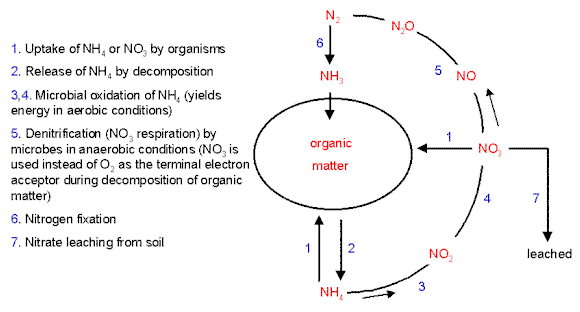 Microbiology Daily Newsletter
Microbiology Daily Newsletter
February 4, 2014 - Metabolism & Growth
Metabolism and Growth are both essential characteristics of life, and are intimately related to each other. You may recall that living systems require CHONPS (carbon, hydrogen, oxygen, nitrogen, phosphorous, and sulfur) to make biomolecules. In addition, we need minerals, trace minerals, and energy in the form of reducing potential (i.e., electrons). The acquisition of carbon and energy are the primary focus of central metabolism (glycolysis, citric acid cycle, etc...) and photosynthesis. But what about the other needs?
Amino acids and nucleic acids both need nitrogen. Nucleic acids need phosphorus in the form of phosphate groups. Sulfur is needed to form disulfide bridges and a variety of thiols. Phosphates become a prime regulator of protein function, and ions are needed to establish membrane potentials. All of these are needed to increase the biomass (growth) of cells.
In looking at microorganisms you need to become accustomed to the metabolic needs and diversity of cells. Though less than 1% of bacteria are culturable, these organisms have helped us understand the dynamic relationship between nutrition, metabolism and growth. They have also provided researchers with known genes that can be used to understand potential functions from genetic analysis.
Today, your goal is to understand how variations in growth conditions can affect bacterial growth, both in terms of biomass accumulation and increases in population size (binary fission).
Heterotrophy vs Autotrophy
These two terms describe the acquisition of carbon. Heterotrophy is used to describe organisms that rely on organic carbon as building block. Autotrophy describes organisms that have the ability to fix carbon dioxide into an organic compound (carbon fixation means adding a CO2 onto an existing organic carbon backbone; this makes the carbon biologically available).Phototrophy vs Chemotrophy
These two terms describe the acquisition of energy in the form of reducing power. Phototrophs have the ability to utilize photons to generate high energy electrons that can be used as reducing potential. Chemotrophs utilize reduced compounds for reducing potential (i.e., energy).The concept of chemotrophs can be further divided in to chemoorganotrophy, in which cells utilize reduced organic compounds for energy, and chemolithotrophy, where cells utilize reduced inorganic compounds for energy.
Nitrogen
Molecular nitrogen is the most abundant gas in our atmosphere, but it is not very accessible by most biological organisms. For nitrogen to become available, it needs to be reduced. Atmospherically this is accomplished by electrical activity, but far more becomes available through biological means. Nitrogen fixation is an important chemical pathway, and is the first step in the nitrogen cycle (the movement of nitrogen through ecosystems). The diagram below provides an explanation of nitrogen fixation: |
Plant Biotechnology Handbook by Niir Board.
|
 |
Nitrogen fixation.http://archive.bio.ed.ac.uk/jdeacon/microbes/nitrogen.htm
|
No comments:
Post a Comment